
Contents
Genetics Index
The Basics
Chromosomes and
Genes
Dominant and Recessive,
Genotype and
Phenotype
Homozygous and
Heterozygous
Sex Chromosomes and
Sex Linkage
X-Inactivation
Mutation
Mutation Basics
Mutation in Syrians
Table of Mutations
Inheritance
Gametes
Punnett Square
Monohybrid Cross
Dihybrid Cross
Trihybrid Cross
Linkage
Sex Linkage
A Common
Misconception
Probability
The Nuts and Bolts
Examples
Principles of Breeding
Breeding Techniques
Dominant Traits
Recessive Traits
Epistasis
Lethality
Inadvisable Crosses
Lineal Purity v.
Heterogeneiry
Tortoiseshells and
Tricolors
Genotyping
Agouti v. Self
Basic Colors
The Golden Genotype
Combination Colors
Coat Types
Patterns
Eye Color
Ear Color
The Preliminary Genotype
Expanding the Genotype
• Parents
• Siblings
• Offspring
River Road Hamstery
(limited version)
Contact
|
Syrian Hamster Genetics: Principles of Breeding Breeding for your dream hamster is limited only by your stock's gene pool. If the genes are there, with a little luck and time you should be able to produce quality hamsters with any combination of color, coat type and pattern you desire, at the same time avoiding matings that are likely to cause problems or just not further your goals. There are two main breeding techniques - selection and crossing. Selection is the careful choosing of individuals for mating, allowing only the best to become parents of the next generation. As a guide to selecting, here is an excerpt from the British Hamster Association Exhibition Standards. The points refer to the relative weighting of each category in the judging. (Standards reproduced by permission of the BHA.)
Type (25 points) In the BHA Standards, specific color and markings criteria are listed for each variety of color, pattern and coat. The complete document can be found at The British Hamster Association. The second breeding technique, crossing, is the pairing of the selected individuals so that the best offspring possible can be produced. Inbreeding involves crosses of first degree relatives. This is done to concentrate desirable genes. Unfortunately, it will also concentrate undesirable genes so it must be accompanied by rigorous selection. Sometimes, because of limited stock, inbreeding is the only way to develop a line. The inbreeding crosses are the backcross (offspring bred to one of its parents) and the sibling cross (brother bred to sister). Of the two, the sibling cross is considered to be the most risky. Linebreeding is the pairing of more distantly related animals. Examples are cousin to cousin, aunt to nephew and grandfather to granddaughter. Linebreeding is a slower process than inbreeding when used to perfect traits, but it is considered somewhat safer with respect to creating genetic defects. Outcrossing is the breeding of totally unrelated animals. It is typically done when you have exceptional animals in every respect but one. A selected individual from the line will be bred to an unrelated animal that has the desired trait. Selected offspring will then be bred back into the line. Even without consideration for show standards, outcrossing is a good way to maintain the production of vigorous animals. (Most mutations for defects are recessive so outcrossing decreases the chance that a defective trait will surface.) Breeding for dominant traits is simple. It is necessary only for one of the parents to have the trait. If this parent is homozygous, 100% of the offspring will have the trait in heterozygous form. Cross: Black Eyed Cream (eeuu) x Sable (eeUU)
Results: 100% Sable (eeUu) If the dominant trait parent is heterozygous, about 50% of the offspring will have the trait, again in heterozygous form. Cross: Black Eyed Cream (eeuu) x Sable (eeUu)
Results: 50% Sable (eeUu), 50% Black Eyed Cream (eeuu)
A dihybrid cross results in a 1:2:1 genotype ratio. If the homozygous dominant is indistinguishable from the heterozygote, then the phenotype ratio will be 3:1. When the homozygous dominant and the heterozygote look different because of incomplete dominance, the phenotype ratio will be the same as for the genotype. Cross: Heterozygous Silver Grey (Sgsg) x Heterozygous Silver Grey (Sgsg)
Results: 25% Silver Grey (SgSg), 50% Heterozygous Silver Grey (Sgsg),
25% Golden (sgsg)
It's not unusual for recessive traits to pop up unexpectedly in a line. If both parents carry a recessive gene in common, 1/4 of the offspring are likely to have the trait. But you can only plan for it if you know your animals have the gene. A planned breeding program to develop a recessive trait starts with an animal that has that trait. It is a two stage process. In the first stage the animal with the recessive trait is bred with any suitable individual. Cross: Rust (bb) x Golden (BB)
Results: 100% Golden (Bb) The second stage can be either a backcross or a sibling cross. The backcross will yield more animals with the trait, but the choice may depend more on which animals seem best for breeding in other ways, like type and temperament.
From the new animals the recessive line can be easily propagated. Chance and linkage are two reasons that a litter's phenotype composition might be other than what was expected. A third is epistasis (or masking) which is suppression of the effect of a gene by a nonallelic gene. In Syrian hamsters, Dark Eared White masks all other colors coded for in the genotype. It does so by removing all pigment from the fur, no matter what color it was supposed to be. White is not a pigment, but instead is the complete lack of pigment.
Another occurrence of color masking is that of Black Eyed Cream over Black because the ee gene pair prevents deposition of black pigment. Suppose you mated two Black hamsters expecting to get an all Black litter. What you didn't know though was that both carried a gene for Black Eyed Cream (aaEe). As the Punnett square shows, about 25% of the litter will be Black Eyed Cream even though they are genotypically Black and Black Eyed Cream together (aaee). A combination color will not be manifest. Black Eyed Cream also masks Yellow.
Sometimes, the presence of Lg or Ds in the parents is not obvious. Light Grey can be mistaken for another grey color, most often heterozygous Silver Grey, but also Extreme Dilute. A Dominant Spot pattern can be missed in certain Roans that are mostly white, especially if the animal is also Banded. Both genes are masked by Dark Eared White — Lg because of epistasis and Ds simply because a white pattern will not show on a white hamster. This can on occasion be the cause of repeated small litters, sometimes with stillborn animals. Mating two hamsters that are Roan or White Bellied (both Whwh) gives litters in which 1/4 of the babies can be expected to be Eyeless Whites (WhWh). Obviously, this is undesirable and should be avoided. However, it is not always clear if a hamster has the Wh gene since it may be obscured by Dark Eared White or another pattern gene. Wh in a Black hamster may be seen only in a larger than usual white belly patch, and in an agouti animal such as a Golden, it may take a seasoned observer to see that the underside is not ivory, but pure white. Eyeless Whites typically have a shortened lifespan of six to twelve months. Breeding two Satins together produces some hamsters, genotype SaSa, that are "doubly satinized." The fur is extremely shiny but very thin and sparse. Introducing Grey into a Black line dilutes the Black color to what has been termed "Dingy Black." Although there are no physical problems with these hamsters, it is an esthetic issue, a jet black animal being ideal for the type. This has also been the reason for avoiding crossing Umbrous into a Black line, but the effect of Umbrous on Black is controversial. Some people believe that it actually makes Blacks blacker by preventing the fading to brown or grey as the animal ages. Others believe that Umbrous amplifies the fading. Some colors are close in hue. Breeding them together can lead to lines in which the colors become indistinguishable, so these pairings are advised against. Examples are Cinnamon to Rust, Black Eyed Cream to Yellow, and a Grey to any other Grey. In general, mixing more and more colors together, instead of producing animals of distinction, results in loss of color quality. Some of these multiply combined colors are impossible to identify. Others have lost the special hue and tone characteristic of the pure color sought for on the show bench.
A pure line is one in which the animals have no mutant genes except those inherent in their phenotype. For example, a pure Honey line (ppToTo, ppToY) will have mutant alleles at the Cinnamon and Yellow loci only, and at these loci it will have no wild type alleles. A pure Golden line has no mutant genes at all. Pure lines are said to "breed true" since all offspring share the parental phenotype. They are useful as a source of that particular color for breeding when extraneous mutant genes would muddy the waters. They serve to maintain the existence of certain colors that are becoming rare. And they are the source of the very best examples of their color. On the other hand, heterogeneity also has its advocates. A heterogeneous hamster (literally, "different kind") has many mutant genes and is heterozygous at many loci. Pairing of these hamsters results in litters with a variety of phenotypes which is pleasing to many people. In addition, there is usually less risk of genetic weakness since the animals tend more to be unrelated. Prudent selection and care with respect to inbreeding still pertain to both programs of breeding. (For the genetic mechanics of sex linkage see the Inheritance section.)
A Tricolor is a Tortoiseshell with a white pattern gene. Whereas Tortoiseshells often do not have distinct patching, Tricolors more often do. The use of Banded v. Dominant Spot is a matter of personal preference. (In Roan, with the intermixing of colored and white hairs, the three different colors would not be appreciated, and in Recessive Dappled there is too little color to start with.) The Banded pattern is more predictable and gives a more reliable distinction between white and colored areas; however, Dominant Spot distributes white over the entire upper surface, matching the distribution of the other two colors. The problems with Dominant Spot are that neither the amount of white nor the amount of brindling (blending of the colors) can be controlled. Also, the white areas can overwhelm the yellow to the point where none are visible. There are numerous approaches to producing Black Torts and Tris; here is one that assumes you start with separate Black and Yellow stock. (To develop Torts/Tris of colors other than Black consider that the second color will be a combination of the base color and Yellow. The greater the contrast, the more attractive the coat.) Since Yellow males are more common than females, the first cross will be Yellow male (AAToY) to Black female (aatoto).
This produces litters where the males are Golden carrying Black and the females are Golden Torts carrying Black. Mating one of these females to a Black male goes like this:
All females from this cross are Black Torts. To create Tricolors, the Dominant Spot or Banded gene can be introduced at any point. Probably the easiest way is to do it early in the crossings, perhaps using a patterned Black female with the original Yellow male. Potential yields of the desired types are halved when a pattern gene is considered since 1/2 the offspring will be unpatterned. |

No part of this website may be reproduced in any form or by any means
without the prior written consent of the owner.





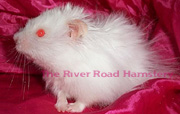 The only time the effect of another color can be seen in conjunction with Dark Eared White is in Flesh Eared
White, the combination of Dark Eared White and Cinnamon. In that case the Cinnamon gene pair removes pigment from the normally grey ears, but no trace of Cinnamon shows in the fur. (This
is the hamster, having no pigment, that is mistakenly referred to as an albino.)
The only time the effect of another color can be seen in conjunction with Dark Eared White is in Flesh Eared
White, the combination of Dark Eared White and Cinnamon. In that case the Cinnamon gene pair removes pigment from the normally grey ears, but no trace of Cinnamon shows in the fur. (This
is the hamster, having no pigment, that is mistakenly referred to as an albino.)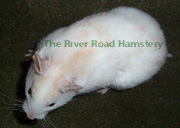 Lethal genes result in death in utero or shortly after birth. In Syrian hamsters Lg (Light, or Lethal,
Grey) and Ds (Dominant Spot) are lethal in homozygotes. In a monhybrid cross (e.g., Lglg x Lglg) 1/4 of the embryos are likely to be homozygous dominant and will not survive.
The litter is then three fourths as large as it would have been and has the remaining genotype (and phenotype) ratio of 2:1. Since the surviving hamsters are healthy, the only
disadvantage of these matings is smaller litters.
Lethal genes result in death in utero or shortly after birth. In Syrian hamsters Lg (Light, or Lethal,
Grey) and Ds (Dominant Spot) are lethal in homozygotes. In a monhybrid cross (e.g., Lglg x Lglg) 1/4 of the embryos are likely to be homozygous dominant and will not survive.
The litter is then three fourths as large as it would have been and has the remaining genotype (and phenotype) ratio of 2:1. Since the surviving hamsters are healthy, the only
disadvantage of these matings is smaller litters.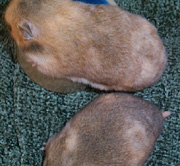 Breeding Tortoiseshells and Tricolors always requires a hamster with theYellow gene. It is the only color
gene in Syrians that is rationalized, causing the the animal to have some areas of the base color and others of that color in combination with Yellow. To the right is a photo of two young
Golden Torts, with lighter patches of Yellow intermixed with the darker Golden. Black Tortoiseshells are the most poplular because of the striking contrast between the Black and
Yellow.
Breeding Tortoiseshells and Tricolors always requires a hamster with theYellow gene. It is the only color
gene in Syrians that is rationalized, causing the the animal to have some areas of the base color and others of that color in combination with Yellow. To the right is a photo of two young
Golden Torts, with lighter patches of Yellow intermixed with the darker Golden. Black Tortoiseshells are the most poplular because of the striking contrast between the Black and
Yellow.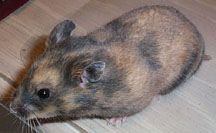 The female to the left is a Black Tort with an unusually large amount of Yellow which in this case is the classic
Yellow Black. Some Black Torts have Yellow areas that are yellow, cream or orange in tone without the expected black overlay. The reason for the variation is largely unknown, but carrying Black Eyed Cream will definitely turn the yellow black patches to cream.
The female to the left is a Black Tort with an unusually large amount of Yellow which in this case is the classic
Yellow Black. Some Black Torts have Yellow areas that are yellow, cream or orange in tone without the expected black overlay. The reason for the variation is largely unknown, but carrying Black Eyed Cream will definitely turn the yellow black patches to cream.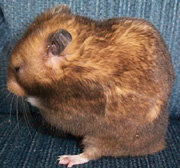 The probability is that 1/8 of the litter will be Black Tort females (highlighted in table). This number is
deceptively low. With the probablity formula we discover that there is actually about a 66% chance that there will be at least one Black Tort in the average Syrian litter of 8. It's a
small scale success. The key to larger yields of Torts is the Yellow Black male (to the right and shaded in table). Pairing the Yellow Black male to a Black female is shown in the next
Punnett square.
The probability is that 1/8 of the litter will be Black Tort females (highlighted in table). This number is
deceptively low. With the probablity formula we discover that there is actually about a 66% chance that there will be at least one Black Tort in the average Syrian litter of 8. It's a
small scale success. The key to larger yields of Torts is the Yellow Black male (to the right and shaded in table). Pairing the Yellow Black male to a Black female is shown in the next
Punnett square.